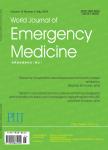A comparison of simulation versus didactics for teaching ultrasound to Swiss medical students
A comparison of simulation versus didactics for teaching ultrasound to Swiss medical students作者机构:School of Medicine University of California Irvine USA Department of Emergency Medicine University of California Irvine Irvine USA University Hospital Basel Basel Switzerland
出 版 物:《World Journal of Emergency Medicine》 (世界急诊医学杂志(英文))
年 卷 期:2019年第10卷第3期
页 面:169-176页
核心收录:
主 题:Ultrasound education POCUS Switzerland Medical education
摘 要:BACKGROUND: Point-of-care ultrasound is an increasingly common imaging modality that is used in a variety of clinical settings. Understanding how to most effectively teach ultrasound is important to ensure that medical students learn pre-clinical content in a manner that promotes retention and clinical competence. We aim to assess the effectiveness of simulation-based ultrasound education in improving medical student competence in physiology in comparison to a traditional didactic ultrasound curriculum. METHODS: Subjects were given a pre and post-test of physiology questions. Subjects were taught various ultrasound techniques via 7 hours of lectures over two days. The control group received 2 additional hours of practice time while the experimental group received 2 hours of case-based simulations. A physiology post-test was administered to all students to complete the two-day course. RESULTS: Totally 115 Swiss medical students were enrolled in our study. The mean precourse ultrasound exam score was 39.5% for the simulation group and 41.6% for the didactic group (P0.05). The mean pre-course physiology exam score was 54.1% for the simulation group and 59.3% for the didactic group (P0.05). The simulation group showed statistically significant improvement on the physiology exam, improving from 54.1% to 75.3%(P0.01). The didactic group also showed statistically signifi cant improvement on the physiology exam, improving from 59.3% to 70.0%(P0.01). CONCLUSION: Our data indicates that both simulation curriculum and standard didactic curriculum can be used to teach ultrasound. Simulation based training showed statistically signifi cant improvement in physiology learning when compared to standard didactic curriculum.



